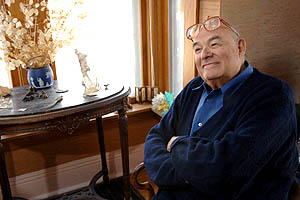After decades of fiction inspired by ‘brutal yet gorgeous’ city, Stern creates ‘intimacy of farewell’
By Jennifer CarnigNews Office
 Richard Stern | |
One could say that Chicago molded Richard Stern.
After all, he left New York to come to the city around 50 years ago, just after the first Mayor Daley—Richard J. Daley—took office, and never wanted to leave. Not Chicago, or the University, where he made his home teaching for 46 years as the Helen A. Regenstein Professor in English Language & Literature and the College.
Though “Emeritus” follows that title now, Stern still feels the same about both the town and the University as he did when he found his way here, where he was the first writer on staff since Thornton Wilder had left in the 1930s.
“There’s something great and complicated about this city that’s different from any place I’ve ever lived,” he explained in the living room of his Hyde Park bungalow. “The University is in the bloodstream of this city and vice-versa. And they’ve both been a great enrichment for me as a person and as a writer.”
The author of nine novels, a novella, a memoir and five short-story collections, including his most recently released volume, Almonds to Zhoof, Stern finds his stories coming back time and time again to the city and the University that have become more than his home — they are the setting in which he locates much of what counts for him.
“In Chicago you can meet anyone you want,” Stern said, opening a book autographed by the current Mayor Daley, a gift presented to him after both men spoke at the memorial service for Saul Bellow at Rockefeller Memorial Chapel last fall. “There’s not that gap between the academic communities, the financial elite, the religious hierarchies and the arts that you see in other cities. Here, people and power groups really interact with each other.”
It is that interaction Stern loves and craves. It is what endears the University community to him. Since his arrival in Chicago in 1955, he has followed the same rule in deciding where to live: Can I walk to the University in 15 minutes? It is the walk which helps “fuse the various segments of your life, teaching, writing, day-dreaming, whatever.”
Decades of lunching at the Quadrangle Club, of befriending brilliant scholars and having complex scientific ideas explained on cocktail napkins by the people who first thought them up, have helped make the city and the University places where Stern’s mind and art feel at home.
The 49 stories published in Almonds to Zhoof, recently dubbed “some of the liveliest and most eloquent stories in American fiction,” by The Village Voice, run the length of Stern’s career. The earliest works were written in 1950, when he was teaching English at the College Jules Ferry in Versailles; the latest were written within the early days of his retirement in 2002. Many include Chicago, and all reflect the “brutal yet gorgeous” city and its politics, neighborhoods, clamor and variety.
“Amazingly enough, when I look at these stories, I remember every single one of them and many events involved in their creation,” he says of the vast narrative survey of his career. “To see and arrange a volume like this, for me, was something like an actor who watches movies he made over 40 years ago. It’s sweet, it’s painful, it’s much of my life laid out on the pages.”
The collection represents a farewell of sorts from Stern to the literary world. Though he just picked up a novel he had stopped writing three years ago, Almonds to Zhoof is the last work he expects to publish.
“That lent a specialness to this book,” Stern said. “There’s the intimacy of farewell here.”
Although it’s clear that his life and surroundings seep into almost everything he’s written, Stern stresses that, as a fiction writer, “ultimately, I make my own world.”
“In a way, nothing bad can happen to a writer,” he said. “Bad things are basically opportunities, lodes of experience that make for powerful ends when they are fictionalized. Writing is not scientific therapy, but it is a form of transformation.”
Just as Stern transforms his life and the lives of those around him into fiction that regularly draws comparisons between the author and his esteemed contemporary Bellow, Chicago and the University have transformed Stern.
Though Chicago molded him and helped make him the author he is today, Stern also hopes that in some way his words have molded the city, or at least his readers’ perception of the city.
“I’ve lived happily in several towns and in the country here and abroad. Each year, my wife and I spend a few pleasant weeks in rural Georgia, but Chicago, indeed Hyde Park, is the home in which my work and life have flourished.”
Reflecting on his many years in the community, Stern likens his understanding of Hyde Park to Proust’s character Aunt Leonie and her understating of Combray: “I know every house and if not every person, tree and dog, I know where they belong and what they probably do. Why live anywhere else?”
![[Chronicle]](/images/sidebar_header_oct06.gif)